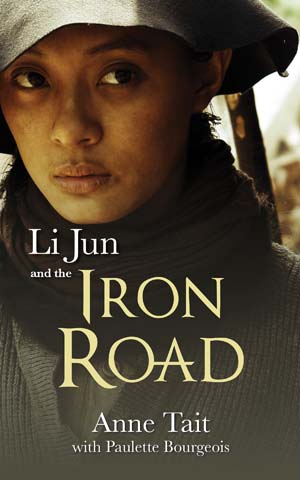| ________________
CM . . .
. Volume XXII Number 5. . . .October 2, 2015
excerpt:
Li Jun and the Iron Road is a novelization of an award-winning mini-series, Iron Road, produced by Anne Tait. The screen story was by Barry Pearson and the screenplay by Barry Pearson and Raymond Storey. Anne Tait, with Paulette Bourgeois, authored the novel based upon that screen play. The novel's strength lies in its depiction of the miserable working conditions endured by the Chinese workers who built Canada's railways in the 1880s. As well, through the eyes of a young woman, readers see the discrimination against Chinese people in Canada and the circumscribed roles for women at that time, both in China and in Canada. Born in a village, Li Jun's life began to fall apart when her father, a teacher, led an unsuccessful farmers' revolt against the Manchu warlords. Then he left to seek work in America, known as "Gold Mountain", and at first sent home money. When Li Jun was 11, he wrote that he was going to British Columbia where work was available in the gold mines and on the railway projects, but, after that, his letters quit coming. Faced with terrible poverty, Li Jun's mother sends her as a household servant to the home of a rich Hong Kong merchant, Mr. Ho. When Mr. Ho gets Li Jun alone, he makes it clear that he has designs on her, but his second wife sees the encounter and threatens to kill Li Jun if she ever goes near him. Being called home to see her sick mother provides Li Jun an escape. Her dying mother's last request is that Li Jun find her father in North America, and, if he is dead, to bring his bones back for burial in China. Taking stock of her situation, Li Jun decides that, to earn enough money for this mission, she must pose as a young man. Three years later, at age 18, she is living in Hong Kong under the name, "Little Tiger", supporting herself by working in a fireworks factory, selling fireworks at a market stall and delivering laundry. One of her laundry customers, Mr. Relic, represents the Nichol Railway Company which is recruiting Chinese men to come to British Columbia. Through Mr. Relic, she meets a handsome young Canadian, James Nichol, son of the railway company president, and from her fireworks factory she recruits 99 of the 100 workers he needs. The hundredth is herself. After enduring a long ocean voyage and hostile reception from Canadians when the ship docks, the workers are taken by train to a railway workers camp where "hundreds of men swarmed like ants". Little Tiger, a cook's helper, soon becomes aware of the men in managerial roles: the Irishman who works as Controller; the scar-faced Chinese ledger-keeper, Bookman, and Mr. Edgar, the engineer. Little Tiger soon distinguishes herself in three incidents involving the use of explosives. The plot developments show the grim statistic noted in the “Historical Afterword”, that three Chinese workers died for every mile of track laid. Little Tiger's cleverness in uncovering a scam to defraud the railway company (dead Chinese on the payroll) puts her life in danger and leads to a situation requiring a dramatic rescue and also some information about her father. Little Tiger's growing friendship with James Nichol provides dramatic tension and stirs reader interest. Eventually she confides her reason for coming to British Columbia and reveals that she is a girl. After hearing her story, James says she is a "lovely brave woman." "I became a man because I had to," she says, emphasizing for the reader that she identifies as a woman. In fact, Li Jun/Little Tiger's successful masquerade of several years is fascinating, but it could do with more detail. Since she is 18 when she meets James Nichol in Hong Kong and goes to America, she must have undergone puberty. How does she conceal her bosom? Is she sufficiently well-nourished to menstruate, and if so, how does she deal with that in a camp full of men where there is little privacy? Apart from the paragraph quoted at the beginning of this review, the authors do not say. History has noted a few women who passed as men in all-male environments for extended time periods. James Gray (Hannah Snell) 1723-1792, a deserted mother, joined the Royal Marines, was sent into battle twice and wounded eleven times. She revealed her gender to her shipmates in 1750 and received a military pension. Another example is James Barry (Margaret Anne Bulkley, 1795-1865) a British Army surgeon who served in India, eventually became Inspector General of Military Hospitals and maintained the secret until death. Several women disguised as men fought in the American Civil War. Li Jun and The Iron Road is very visual in its presentation, as one would expect when one of the co-authors, Anne Tait, is an award-winning stage and screen writer and film producer. The other co-author, Paulette Bourgeois, has won awards for her children's and young adult fiction and is a member of the Order of Canada. The novel, and possibly the mini-series on which it is based, would be worthy additions to school and public libraries. Recommended. Ruth Latta's young adult novels include The Secret of White Birch Road and The Songcatcher and Me. The working title of her current novel-in-progress is Gracie and the Secret Vault. For more information visit http://ruthlattabooks.blogspot.com.
To comment
on this title or this review, send mail to cm@umanitoba.ca.
Copyright © the Manitoba Library Association. Reproduction for personal
use is permitted only if this copyright notice is maintained. Any
other reproduction is prohibited without permission.
Next Review |
Table of Contents for This Issue
- October 2, 2015. |
